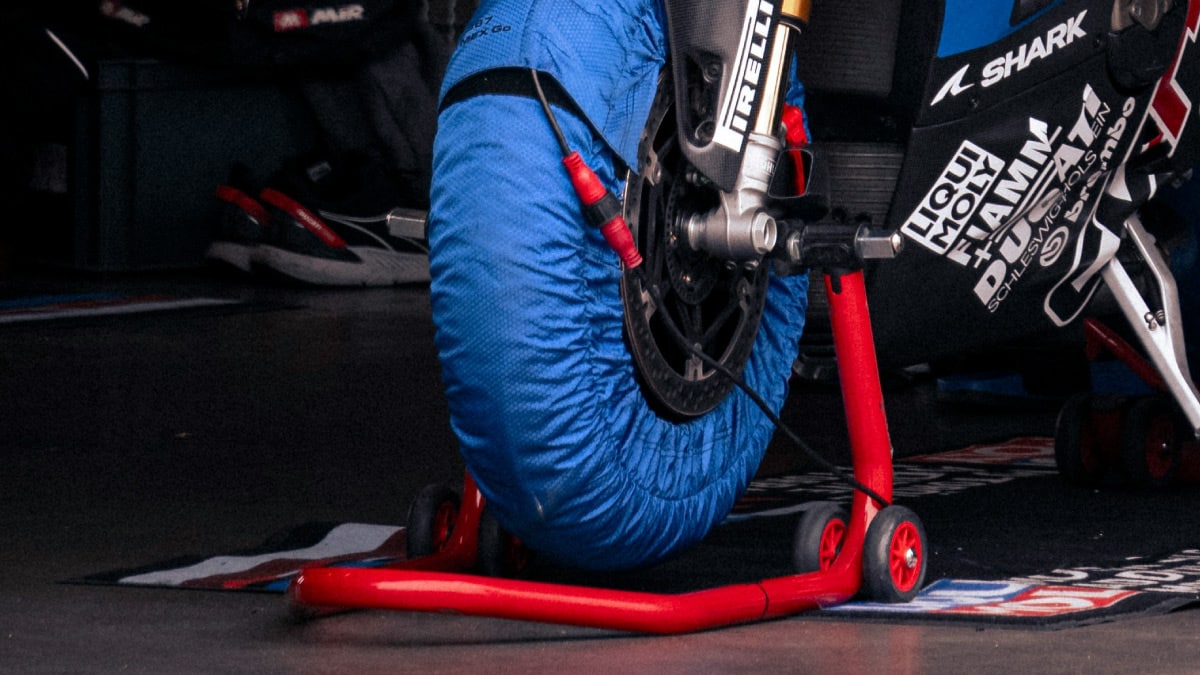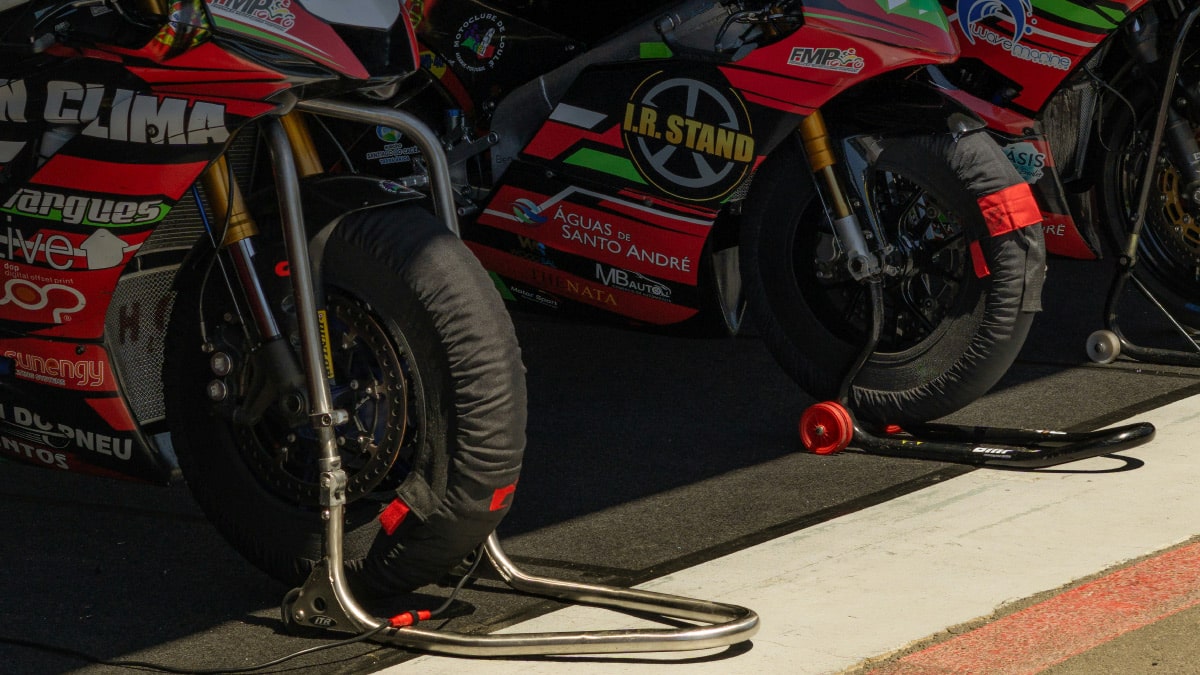THRYLLZ
Thrills we thrive on
Thrills we thrive on
Using paddock stands. Why would you, if your motorbike already has a side stand? Paddock stands are widely used on the track. Does that mean you only need or can use them when you ride on track? Certainly not!
Why are paddock stands so useful for your motorbike? The simple answer is that they are practical. Is it practical to have to carry them around with you everywhere you go? No. But once your motorbike is on them, you will be glad you have them. In principle, a paddock stand is the same as a side stand for your motorbike. You rest your motorbike on it. Why is it so much more convenient? We will explain.
Contents:
1. What are paddock stands?
2. What are the advantages of paddock stands?
3. How do paddock stands work?
4. Different types
5. How do you put a motorbike on paddock stands?
6. Conclusion
Paddock stands are separate stands for your motorbike. One paddock stand holds up one side of your motorbike. For example, the rear (and therefore the rear wheel) or the front (and therefore the front wheel). You can buy a separate stand for the rear of your motorbike. Even more practical is a set, which gives you a paddock stand for both the front and rear of your motorbike.
In addition to keeping a motorbike stable on paddock stands, the biggest advantage is that your wheels are off the ground. They are widely used in racing because they allow tyre warmers to be placed around the tyres. This keeps the tyres at the right temperature for maximum grip when riding on track.
But they are not only useful for racers. Because your rear wheel is off the ground, tasks such as lubricating your chain become easy. Tensioning your chain is also easier (and more accurate) when your motorbike is upright on a paddock stand.
Paddock stands are also recommended for use when storing your motorbike for the winter. This prevents the entire weight of your motorbike from pressing on one point of your tyres all the time. Want to give some TLC to your brakes? Then they also give you a little more convenience.
The disadvantage of paddock stands? You always have to take them with you. If your motorbike has a side stand, it is attached to your motorbike. Because they have to be carried separately, they take up more space. And you have to remember to take them with you. You also always have to find somewhere to store them. But that’s about the only disadvantage.
There are several types of paddock stands. We will tell you more about them later. In principle, they all work the same. Sometimes the way your motorbike rests on the stands differs. A paddock stand works like a lever. By clamping the stand under the bobbins – a kind of protruding caps in the rear swing arm of your motorbike – you lift the rear of your motorbike.
Whether this is done with bobbins or another type of attachment, the technique remains the same. The lever action lifts the rear or front of your motorbike. Because the motorbike rests on the paddock stands with its weight, it remains stable and secure.

You often have separate paddock stands for your front and rear wheels. After all, your front wheel is almost always narrower than your rear wheel, which means that the width of the stands also differs. We mentioned earlier that you can often lift a motorbike with these stands by using bobbins.
Bobbins are a type of small support. These bobbins are screwed into the rear swing arm of your motorbike. This is by far the most commonly used technique for using paddock stands. They are easy to screw into the rear swing arm and easy to replace if they break in the event of a fall. Bobbin screws come in different thread sizes, so always check which size your motorbike needs. Please note that this attachment is only for your rear wheel.
Not every motorbike offers the option of placing bobbins in the rear swing arm. In this case, you can use paddock stands with an L-adapter. These supports are attached to it. Your rear swing arm or the bottom of your front forks then rests on these L-adapters. These stands can be used for practically any motorbike. The only disadvantage of this attachment is that your motorbike is slightly less stable.
The paddock stand for your front wheel often includes conical adapters. These adapters are a type of pin. These pins fit into the openings under your front fork. The pins are mounted on your front stand. These pins ensure that the front of your motorbike is stable.
Another variant is the type that lifts your motorbike via the steering head. It takes some skill to lift your motorbike using this stand. However, your motorbike is by far the most stable on this paddock stand. Another big advantage is that your front forks are free. This makes it easy to change or adjust your front forks, for example.
There are also paddock stands for motorbikes with a single-sided swing arm. This stand has a protruding part that you slide into the axle of your rear wheel. The size of this part varies depending on the brand or model of motorbike, which makes this type less universal.
Finally, there are stands that you insert into the centre of your motorcycle’s axle. These so-called “centre paddock stands” lift your motorcycle up as a whole. These paddock stands are often on wheels, making manoeuvring your motorcycle a breeze. Please note that these stands often have a maximum load capacity.
Placing your motorbike on the paddock stand – especially on the rear stand – requires some skill. It may take a while to get the hang of it. After all, you have to put your motorbike upright and then hold it with one hand at the rear, before sliding the rear stand under the bobbins or rear swing arm. Once the rear stand is balancing your motorbike, you can apply force to lift your motorbike up and place it on the stand.
It’s actually a kind of lever effect. You flip your motorbike up, as it were. To remove your motorbike from the paddock stand, lift the stand very gently. Slowly lower the motorbike back to the ground with the rear wheel. Keep your motorbike balanced with one hand on the rear. Or rest your motorbike against your leg for some extra stability.
It’s quite logical if you find this a bit nerve-wracking at first. In that case, do it with someone else. First, lift the stand yourself while someone else holds your motorbike. Then hold your motorbike yourself while someone else lifts the rear stand underneath it. This will give you a feel for what your motorbike does when it is lifted by the stand.
Next, practise standing next to your motorbike and putting it upright. Keep it balanced with one hand on the rear and try to slide the stand underneath, while someone stands in front of or next to your motorbike as a “safety net”. If your motorbike does lose its balance, that person can catch it for you. This simply takes practice. Before you know it, you’ll be doing it all by yourself.
The front stand is often a lot easier. You can simply slide it underneath, making lifting the front of your motorbike a simple task. Please note: first place your motorbike on the rear stand and only then on the front stand.

We find paddock stands much more convenient than a side stand. Okay, not for on the road. Taking your stands with you on a ride is not an option. But when you park your motorbike at home or in the garage, they provide much more stability and freedom. There are even paddock stands on wheels, making it easy to move your motorbike around and park it in the smallest of spaces.
It takes a bit of skill to put your motorbike on them, but once you get used to it, it’s a piece of cake. Whether you want to do some maintenance, ride on the track or clean your chain: paddock stands make it easy. And at some point, you won’t want to be without them.
We use cookies to improve your experience on our site. By using our site, you consent to cookies.
Websites store cookies to enhance functionality and personalise your experience. You can manage your preferences, but blocking some cookies may impact site performance and services.
Essential cookies enable basic functions and are necessary for the proper function of the website.